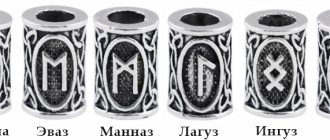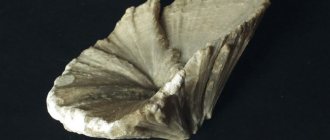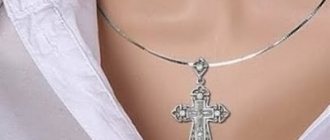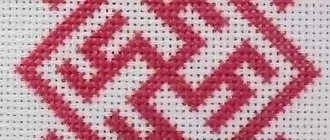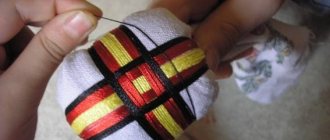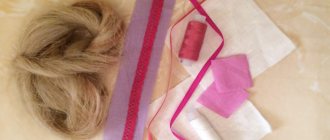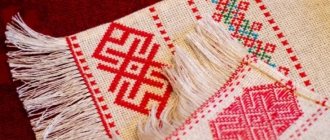History of appearance
Nobody knows exactly when and how the first amulets appeared. Scientists agree that initially the ritual role of this object was paramount. The period of childhood was quickly ending, girls entered adulthood early. There was no time to play.
With the development of civilization, the doll gradually became a means of entertainment, training, education, without losing its sacred meaning. The amulets were made in the image and likeness of a person, but with additions in the form of sacramental symbols.
For example, the figurine was missing a face, arms, and legs. Why do the ancient Slavs think there are extra “eyes” in the house? And the legs are of no use - what if he runs away?.. The head obviously became round, like the eternal sun, the body personified the connection with the afterlife.
The ancestors, one might say, humanized the artificial creation. The toy came to life in the hands of the master and became a dear member of the family. The doll protected her relatives, and they, in turn, protected her.
A little history
The history of the folk doll, which was used on holidays or during folk rituals, goes back to those years when there was paganism in Rus'. Long before the Baptism of Rus', the Slavs celebrated the resurrection of Dazhdbog every spring, baking Easter cakes, which they then sacrificed to him. Even then, pysanka was a magical talisman of the ancient Slavs.
According to historians, with the introduction of the Orthodox religion, each pagan holiday gradually acquired Christian significance: the ancient holiday Kolyada (winter solstice) became the Nativity of Christ, Kupala (summer solstice) became the holiday of John the Baptist, Christian Easter coincided with the spring Slavic holiday called Velikden. The tradition of painting Easter eggs and baking Easter cakes also came from ancient celebrations of the Great Day.
From there arose the tradition of making ritual Easter dolls and motanka dolls, which are considered the most powerful amulets for women.
Slavic amulets and their meaning
Ancient people perceived inexplicable phenomena as supernatural. Is your child sick? Consequently, the visiting guest has jinxed it. There is no peace in the family - evil spirits are at work. There was a crop failure - the gods were poorly appeased. And so on. The world of the Slavs was inhabited by dark and light forces, between which man, according to the ideas of his ancestors, had to constantly balance.
Amulet figurines existed for all occasions. Based on their purpose, they are conventionally divided into 7 categories:
- protective (from illness, damage);
- to fulfill wishes (the doll was given something);
- protective (for the well-being of the family, on the road);
- symbolic (symbol of the connection between mother and child, love of the newlyweds);
- festive, solemn, ritual (on the day of Ivan Kupala, the holiday of Evdokia-Plyushchikha, on Palm Sunday, for example);
- everyday ones (the figurine “Grandma Girl” as a hint that a future bride lives in the house);
- assistants (in the household, in everyday life).
Can you imagine how many dolls there were in the home of the then Slav! After all, every family wanted to protect itself from all sides. A girl was allowed to make a toy on her own at the age of 11-13. It was a kind of test.
How the daughter coped was used to evaluate her readiness to become a wife. The products of future brides were sacredly kept in chests until the significant date, and then passed on by inheritance.
Return to contents
Ritual dolls
Folk ritual dolls were performed in compliance with ancient rules (without a needle and thread) for a specific ritual, and then burned (Maslenitsa, Kolyada), drowned (Kupavka) or buried in the ground (Likhomanka, Kostroma). Sometimes the dolls were then given to children to play with:
- Kostroma - made for Maslenitsa, it was placed for the entire holiday week, and then burned.
- An Easter doll (the head is made of an egg) and an Easter dove (always bright red) were used to decorate the house for Easter.
- Kupavka was made on the holiday of Ivan Kupala, then it was celebrated on the water, and by the way it floated (whether it went into a whirlpool, floated freely, or washed ashore), they predicted what the whole year would be like.
- Vesnyanka - friends gave to each other, calling for the imminent arrival of spring.
- Fertility - a doll depicting a mother of many children attracted wealth to the family.
- Fever dolls - usually 13 pieces were made to protect the child from diseases; they were displayed in a row on the stove.
- A nurse with large breasts, the bigger the better.
- The herbal pot, a useful doll filled with fragrant medicinal herbs, purified the air in the hut or above the baby’s cradle, driving away the spirits of disease (the grass needs to be changed every 2 years).
- Kuvad dolls were intended for men; during the birth of their wives, they provided protection with the help of magical rituals (kuvads) from evil spirits. Immediately after a happy birth, the dolls were burned in a cleansing ritual. Starting from the end of the 19th century, folk dolls began to be used in a different way: they were hung over the baby’s cradle as amulets or placed directly in the crib so that the baby could play in the absence of the mother (often there were several of them of different colors, they were a replacement for rattles).
Many ritual dolls were also protective.
Types of dolls in Rus'
All Old Slavic dolls were made from natural materials - clay, straw, rag scraps, bones, etc. Therefore, their remains are not found in the ground - they quickly decompose. But ethnographers still managed to convey to us information about the ancient Russian fetish. So, as a result of research, it became clear that dolls were divided into 3 main types.
Children's games
It was not the matryoshka doll that was originally used as a doll for fun. It was invented later - in the 19th century. The first play dolls were similar to ritual dolls. Without face and other body parts. Only over time did the toy gain eyes. Parents treated such fun with great trepidation and respect and taught their child to do it.
| By the way the child treated the doll, adults judged the well-being of the future family. If a girl plays hard, life will pass in abundance; if she plays sloppily, trouble cannot be avoided. |
Children's toys had an important educational function. Thus, the “Wretched” (a deliberately poorly dressed doll) developed compassion, the “Bird” (imitated a baby in diapers) prepared for caring for babies, the “Bunny” (worn on a finger) taught not to be afraid to stay at home alone.
Moreover, not only kids, but also adult girls played with doll figures. They took numerous crafts to friendly gatherings and to work in the fields. They compared them with each other and showed off at fairs.
Ritual dolls in Rus'
The rite is an integral ritual in the life of ancient society. Great hopes were placed on the successful results of the cult action - fertility, healing, deliverance from troubles. They did not spare anything for finding happiness. Even people. It’s scary to think, but back then it was considered normal to bring a living person to the gods for slaughter. It was dolls that saved innocent souls!
At first it was an ordinary log, dressed up in a scarf or dress. Then they came up with other stuffed animals - Mermaid, Moreno, Pokosnitsa, etc. Everyone’s favorite Maslenitsa has survived to this day, in honor of which a festive fire is held every year.
Protective dolls
As mentioned above, the Slavs had many totem dolls that protected them from evil. Each of them had its own fancy name - Montanka, Pelenashka, Makosh, Travnitsa, Desyatiruchka, Bell, Denezhnitsa, etc. Among this protective regiment, a clever, cunning old brownie, popular even today, occupied a place of honor. He kept peace in the house and kept order.
The favor of the crafty old man was bribed with delicious treats and toys. According to mythology, he was considered the forefather of the family, so they were very afraid of angering the brownie.
| Did you know that every house has its own magical owner? And if none of the residents saw him or noticed his mischief, then he is happy in this family. They also say that brownies love horses. |
To appease the naughty person, you need to keep your home clean and maintain good relations between relatives. Otherwise, the brownie will take revenge - drop objects, knock, make noise and even strangle you at night.
Return to contents
Playing children's dolls
Playing folk dolls were made for small children so that they would have more fun with them. They were made only from natural materials: grass, pine cones, clay, charcoal, moss and fabric. All dolls had to be faceless so that the soul could not move into them, and they could not be used for witchcraft. Children's play dolls have always been protective in order to protect the child from evil spirits. Traditional rag dolls, made especially for children, had their own names:
- Ash doll - the first children's dolls were made from ash, which was taken from the hearth, then mixed with water and rolled into a ball to form a head; Such dolls were considered a strong amulet for a child.
- A friend doll was made so that the child would not be afraid to stay at home alone (for example, “bunny on the finger”, bird, spin dolls). Such a doll (folk) is a toy that was made by a grandmother together with her granddaughters, a mother together with her daughters, teaching them and at the same time accustoming them to creativity and hard work.
- The bird doll was made from a piece of bright fabric in the shape of a square, giving the shape of a bird using threads. Such birds are made small and hung in the corners of the house or above the child’s crib.
- A diaper - a doll swaddled with cloth, was placed in the baby's cradle to take on all the misfortunes from evil spirits.
- Senya-Malina, a doll with a sunny red mane, conveying the image of a handsome man in a bright shirt, was popular in the villages of Northern Pomerania, various fairy tales were written about him and was called the northern Munchausen.
What are Slavic dolls made of?
What could an ancient Slav make a craft from? Of course, from scrap materials. Scraps of fabric, thread, wood (branches), straw, clay, grain, even bread crumb, cheese. They tried to make the figures bright. The color red was often used, which, according to pagans, had a powerful energetic power of protection.
Symbolic patterns were embroidered on dresses:
- Circles and crosses represented the sun.
- Deer, women - fertility.
- Waves - water.
- Horizontal and vertical lines - the ground, trees, respectively.
- Diamonds with dots - field.
Interestingly, at first men were not allowed to work in the craft. Only women are the keepers of the hearth. But over time, the male masters still joined the art. Yes, that’s understandable. In order to carve a figurine from wood, you need not only creative imagination, but also physical strength.
Motanka dolls
The Slavic motanka doll takes its origins from the Trypillian culture. Its basis is a twisted svarga, the prototype of which is represented in a variety of motifs on clay products found during excavations of burials of the Trypillian era.
Svarga is a symbol of movement, spiral and energy vortices, obtained by twisting and twisting, which has ritual significance. Instead of a face, she had a cross, which testified to her being outside of time and space. She is the archetype of the Great Goddess.
The motanka doll is made without the use of cutting or stabbing tools, only natural materials are taken: straw, herbs, flowers, corn cobs, grains, pieces of worn fabrics (you just need to make sure that the fabrics are from “lucky” old clothes), which were previously worn by loved ones People.
When making the body of the reel, no knots can be tied, the only exception being a small knot at the end, symbolizing the tying of the umbilical cord. While tying it, the craftswoman must make a wish and secure it with her strength. Sometimes arms are made separately, which are then tied to the body.
The outfit and headdress are made separately; it can be embroidered and decorated with lace. Each element has its own meaning:
- the skirt is a symbol of the earth, the wavy line on it is a connection with water;
- shirt - the trinity of the world;
- decorations on the head (ribbon, scarf) are a symbol of connection with the sky.
All separately made parts and decorations are manually wound to the body. Our ancestors were sure that if a doll is started, then it must be finished, otherwise misfortunes will come. Not a single woman left work unfinished, because she was afraid that this would bring trouble and illness to her family.
The most famous amulets dolls
Here is an overview and description of the most common amulets dolls in Rus'.
Zolnaya
Ancestors treated fire and the ashes left behind with great respect. It was not thrown away, but carefully put in a secluded place. A doll was made from dust - a symbol of the family hearth. The ash was rolled into a ball, moistened a little with water, and thrombosed.
Then they covered it with white cloth and bandaged it. The result was a head. The body was made from wound fabric. They dressed the keeper in a folk costume, and tied a small doll made in the same way behind her.
The amulet was given to children for a wedding. It was as if the newlyweds were taking a piece of home with them. On ordinary days, the talisman was not hidden, but on the contrary, it was put on display. He met and saw off guests.
Krupenichka
The name comes from the word cereal. During the harvest, the doll was tightly stuffed with buckwheat or millet. Why did she become plump and potbellied? The figure symbolized wealth, well-being and occupied a place of honor in the red corner. In times of famine, the family ate grains from there a little at a time. In poor houses, Krupenichka was thin, but in wealthy houses she was fat.
Herbalist-Kubishka
Protected from diseases and evil spirits. The figurine was filled with medicinal herbs, which emitted fragrant odors throughout the hut. They stored it for 2 years and then made a new one. The Herbalist, who was nicknamed the Kubushka for good reason, had an unusual appearance. There are continuous nodules on the pot-bellied body - two on the arms and chest, the head, the body. Total 6.
The “tumbler” was hung over the bed of a sick person, a baby, or simply given to children to play with. By the way, Kubyshka is also a godsend for modern people. We don’t know what about perfumes, but with the help of the Herbalist, you can really create real aromatherapy at home.
Pelenashka
A favorite toy for girls, a strong protective amulet for a baby. The diaper was a doll wrapped in diapers. Did you know that swaddling is not just wrapping a baby, but a whole ritual. It turns out that in this way the ancestors protected newborns from evil spirits.
The baby, like a dead person, was tightly wrapped in swaddling clothes. The pagans believed that some evil spirit would fly into the house, see the rewound bag, think that it was lifeless and would not maim.
Return to contents
Lovebirds
Folk amulet doll 2 in 1, popular at weddings. The puppet bride and groom had one common hand. The talisman personified family happiness, strong love, and the unity of masculine and feminine principles.
Purifier
She healed the sick from physical and spiritual illness, but only if the person in need of help made the doll himself. The rule was this: while working, focus on the problem and mentally transfer the negative energy to the Purifier. Another condition is that the figurine should look like its owner. After the person recovered, the doll that had absorbed the disease was burned.
Desire
Bereginya for fulfillment of desires. The body of the doll was made of twisted fabric (column). A folk dress was put on the base. Girls, in order to achieve what they had planned (for example, a successful marriage), decorated the Zhelannitsa with beads, patterns, bows and hid it from prying eyes.
Ten-handle
Eh... Such an amulet would not hurt a modern housewife. The figurine had 10 hands, each of which symbolically had its own purpose in everyday life. A ten-handed coin was usually given to a young bride to help with household chores and ease the woman’s lot. The doll was made from straw or bast.
Day Night
These are two dolls made of white and blue fabric, tied together with one thread. The talisman was created to protect the home. It was distributed in the Volga region, Penza and Tambov provinces.
bbw
Favored a woman's pregnancy and saved her from loneliness. It was impossible to sew a talisman for yourself. The matter was entrusted to the grandmother, sister, goddaughter, etc. through the female line. The doll was made in the form of a small child, in the form of a teenager, or an adult girl.
plantain
A protective doll for good luck on the road. A bag containing grain, ash, salt or a pinch of native soil was attached to her hands. Only the one who makes it and to whom it was intended was allowed to touch the amulet.
Bird Joy
The ancient Slavs loved spring. They eagerly awaited her arrival and lured her in by arranging colorful rituals. For the ritual, women prepared special dolls with a scarf on their heads in the shape of a bird, dressed themselves in similar outfits, went out into the field and invited warmth with songs.
Veduchka, or leading to life
She personified the eternal change of generations, female wisdom. She was depicted as a woman leading a child in front of her. In a figurative sense, the image meant leading a child through life, who would then take the mother’s place and also become a leader.
Return to contents
Dolls Krupenichka and Man Rich
Zernovushka, as it is also called differently. The body was stuffed with rice, pearl barley, buckwheat, and oats. A variation of Krupenichka was the peasant Bogach, made using the same method. They were placed in pairs with each other in a prominent place in the house to bring wealth to the family and get rid of debts. As a rule, dolls were made during the harvest. In the spring, grains were poured out and sown along with other crops.
Baba Yaga
Oddly enough, the old hag Baba Yaga protected the hearth of the Slavs. This mythological character had magical powers. With the help of a doll, a ritual was performed to save a sick child, which directly resonates with an episode of Russian folk tales. A sick baby was placed in rolled out dough, spoken to and sent into the oven (mother's womb). There he allegedly gained strength, grew stronger, and recovered.
Pock
It was prepared from rowan sticks, which, according to the ancestors, warded off evil spirits. A protective amulet was placed at the entrance to prevent any kikimora from entering the house.
Well-being
This is such a universal protector from troubles and well-being in all endeavors. Guardian angel of the family. The mistress of the house herself made it, then passed it on to her children to attract good luck.
Successful
From the name it is clear the purpose of this figure - to attract success to the side of a specific cause. The wish for Success was spoken out while working on it.
Odolen-Grass
She had the strongest protective energy. She could defeat a serious illness, get rid of damage, cleanse her spiritually and physically. On the doll's chest there was a symbol of the Sun - a solar sign.
Thread of Fate
The doll holds a ball of fate in her hands. Protects a person in despondency and sadness. Brings good luck, prosperity, clears the head of dark thoughts, points to the true path.
Kolyada
Yuletide, Christmas doll. Dressed festively, in her hands - bags of bread and salt. She brought happiness and joy to the house. After the holiday it was burned. An analogue of such a toy for Christmastide is a goat doll.
Six-handle
Or Filippovka. Similar to Ten-Handed, but has 4 fewer arms. On his belt is a bag of grain and coins. Patron of women needlewomen.
Kupalo
It echoes the holiday - Ivan Kupala Day. A symbol of love, strong family ties.
Bell
A cheerful doll in three skirts, representing the 3 kingdoms - copper, silver, gold. Brings a good mood and joy.
Return to contents
Spiridon-solstice
Ritual doll associated with the patron of crafts, the god Svarog. He spins a wheel with 8 spokes in his hands - he brings the desired changes in life.
How to make a protective doll from fabric
There are the following types of amulets dolls: those that promote health, prosperity, and protect against outside evil.
Note! Creating a magical assistant is a creative process, but there are also rules for its implementation that have developed over a long time.
The first rule for Slavic dolls: they are made without a face, that is, they do not draw eyes, nose, or mouth. Distant ancestors believed that an evil spirit could enter the figurine through the eyes. And in modern culture, dolls with faces are a frequent attribute of horror films.
The face of the Slavic protectors of the family was made of white fabric - a symbol of the pure thoughts of the craftswoman. A cross was sometimes painted on a white face. The cross was a sacred symbol in pagan Rus', representing the sun.
The second rule, developed throughout the history of amulets dolls in Rus': when making them, you cannot use scissors and a needle. The fabric is simply torn off, not cut, the threads are gnawed, all parts of the amulet are wound or tied with threads. Therefore, the second name for the pupae is “rvanki”. The Slavs believed that cutting fabric or threads or piercing the material with a needle meant depriving the future amulet of energy.
Third rule: only women participate in the ritual of creating magical guardians. The amulet will be more powerful if it is made by not one, but several female relatives.
The fourth rule: the keeper of the hearth must begin to create in a suitable state of mind - calm and rested. In the process, the woman thinks about the person for whom she is creating a mystical guardian, thinks about what he will protect from and what qualities he will strengthen. A doll made by yourself for a loved one is always a more powerful amulet than a purchased product.
Another rule: the doll is twisted on your lap; it is better not to use a table. This is how the little bereginya is filled with only the energy of the creator. The Slavs considered the table a place where the energies of family members mixed.
From the available ethnographic information about amulets dolls, one can learn that the materials for such crafts should be natural and undyed. It’s even better to take a scrap of used clothing from family members (unless these clothes were “lucky” and are not accompanied by unpleasant memories). The threads for doll amulets are red.
Rag helpers are stuffed with grain or dry herbs. Herbs are selected based on their properties. For example, if a young wife cannot get pregnant, the amulet is filled with archilimus. Gladiolus is good for health, cornflower gives protection from evil people, St. John's wort protects babies from bad outside influences.
If something didn’t work out while working on the amulet, the fabric fell or tore incorrectly, the ancestors believed that this was the work of dark forces. Then the words of the slander were uttered:
Important! Depending on the types of amulets, an odd or even number of skeins and knots are made. The principle for all dolls is to wind the salting clockwise.
The magical assistant must be done in one sitting. You cannot interrupt the process of creation, much less stretch it out for two or three days. You need to find enough time and create the doll in one go.
People refrain from making homemade bereginas on major holidays. You should not start working on mystical symbols on Friday and Sunday.
Magic dolls can not only be made from rags and scraps, but also twisted from threads. Such products are called “motanki” - even children could make them. Now master classes on thread dolls are held in kindergartens.
Kids are asked to take two skeins of thread - red or pink (for the body) and white (for future hair). Wind pink threads onto a piece of cardboard until you get a small skein. Remove the skein from the cardboard and tie the upper part with thread - you get a head and neck.
White threads - hair - are also wound on cardboard, then the skein is removed from it. Cut it on both sides - there should be free threads at the ends. Thread the “hair” through the head and tie a knot. Then you can braid your hair.
Two more pieces are made from pink threads - hands. When they are removed from the cardboard, they are tied on both sides with thread. Then the arms are threaded through the body and secured with thread again.
The legs are obtained by dividing the main skein and tying with thread. If this is a female figurine, then they simply cut off the main skein - a fluffy skirt comes out.
The photo shows how you can decorate the dolls with ribbons and beads.
Beregini help their owner for varying amounts of time. Some amulets need to be burned or thrown into the river when they have served a certain period of time, others are passed down in the family from mother to daughters and granddaughters.
You need to say goodbye to your little helper who has served his purpose correctly. First, the figurine is disassembled - only with your hands, without scissors or knives. Then the components are burned in a stove or over an open fire; you can throw the scraps into the river (flowing water). Before destruction, you need to thank the coast guard for your help.
There are pupae that work within a certain period of time. From Krupenichka-Zernovushka, the guarantee of satiety for all households and the well-being of the family, in the spring before sowing, grain is taken out and planted - until the fall, when new grain grows, the pupa rests.
Rules for making amulets dolls
Inventing protective dolls is not an easy task, although it does not require intricate patterns. Neatness and neatness are the first thing. The second and, perhaps, the most important thing is compliance with magical nuances.
Here are the requirements to meet:
- Take fabric material from old clothes - it preserves the energy of the owner.
- Do not use sharp objects in your work - scissors, needles, knives, hooks (“life will be stabbed”). Slavic dolls were not sewn, but were made using the hosiery technique or the method of winding (strictly clockwise), twisting, and tying with threads.
- The amulet must be without a face, otherwise it will steal the owner’s soul.
- Puppetry loves silence (they crafted in silence), you need to start and finish needlework in a good mood.
- The totem had to be made in one go, without stretching the process.
- On Friday, Sunday, and holidays, it was forbidden to make crafts.
- Read conspiracies. To increase the power of the ritual object, the girls repeated incantatory words and prayers while working and generally talked a lot with the dolls. They are alive, they hear and can do everything.
Rag dolls
Starting at the age of five, girls themselves began to “twirl” their dolls under the guidance of their grandmother or mother. The folk rag doll was made from wool or cotton pieces of fabric, flax and multi-colored ribbons and threads. You only had to make a rag doll with a good mood and love. According to tradition, it was also customary to sing and talk, and make a wish.
Twist dolls (or another name for a column) are made by twisting a piece of fabric or a birch bark tube, onto which clothing parts are then put on: a shirt, a skirt, a sundress, a warmer; a braid of thread or yarn is made on the head, secured with a scarf.
When making all toys, it was forbidden to use threads and needles, as well as to paint the dolls' faces: it always remained pure white.
Folk Doll Museum
Since the 1990s, museums of folk dolls, telling about Russian puppet culture, began to appear in Russia and became very popular. Now there are already about 20 such projects operating in the country, some also represent original and antique copies:
- The Moscow Museum “Doll House” was created in 1993 through the efforts of Russian cultural figures (O. Okudazhava), has a collection of antique dolls, houses for dolls, an exhibition of folk and theatrical pieces.
- Museum of Unique Dolls (created in 1996 by Yu. Vishnevskaya) - contains a collection of specimens of the Russian Empire of the 19th-20th centuries, European dolls, Asian dolls, and toy houses.
- Museum of Folk Toys "Zabavushka" - presents collections of clay, straw, patchwork exhibits, and Russian folk dolls are also presented here.
- Museum of Toys in Sergiev Posad (founded in 1918 by collector N.D. Bartram) - exhibits a collection of ancient clay and wood products, porcelain dolls in Russian folk costumes, a collection of toys for the children of Russian Emperor Nicholas II;
- St. Petersburg Doll Museum - since 1998, presents collections of modern and folk exhibits, holds thematic exhibitions (40 thousand items are stored in the museum: dolls, furnishings, clothing, ethnographic items, souvenir items in historical costumes of various eras and peoples , original works of modern masters and designers).
- Museum-estate “Bereginya” (Kozlovo village, Kaluga region) - under the leadership of folk craftswoman Tarasova, 2,000 traditional dolls from all over Russia were collected; Among the exhibits are examples of traditional crafts (Gzhel, Filimonovskaya, Dymkovo, etc.), toys in the national costumes of the regions of Russia and the peoples of the world (40 countries).
Dolls from the “DeAgostini” series
A series that includes dolls in folk costumes, produced by . The series consists of 80 issues, each of which contains not only a porcelain toy in the national costume of a certain region of the country, but also a description of the details of clothing, the history of the location, traditions and customs of the region and other interesting information.
A traditional Russian folk doll is a holistic idea of our Slavic ancestors about the structure of the world and the universe, expressed through folk art and handicrafts, which supported a person in his spiritual life.
Dolls in Russian folk costumes
For a long time, the clothing of a Russian woman had distinctive features and characteristics, by which one could determine her age and class, what region she came from, her occupation and whether she was married. Each Russian province differed in its own styles and colors in the formation of folk costume.
The Russian national outfit has one main feature - a simple silhouette that does not emphasize the shape of the body. This simplicity was balanced by a variety of colors in different parts of the clothing, in bright trim, embroidery and multi-color appliqués. The folk costume, which our ancestors wore until the beginning of the 20th century, was made taking into account not to hinder human movement and to be comfortable at any time of the year under different weather conditions. Structurally, the costume was made in such a way that there was almost no need for scissors or sewing. The main elements of clothing are a shirt (of different lengths: shorter for men, almost to the toes for women), a sundress or a skirt (poneva). The women embroidered all this very beautifully and decorated it with decorative elements. They always wore a scarf or kokoshnik on their heads.
Dolls in folk costumes, which were made by women in a specific region of Russia, were also distinguished by their appearance. Rag dolls were usually given to relatives to cement blood ties. Often clothes for toys also had features inherent in local costumes. An important principle by which folk dolls were made was that the costume could not be removed; the toy, together with the clothes, represented an integral image unique to it.
At the same time, the costume determined the ethnically specific type of doll, which could not be changed, assigning a certain role in children's amusements. For example, a toy in a pink sundress could not play the role of an adult married woman in the game, and a “wifey” doll could not be a bride.
